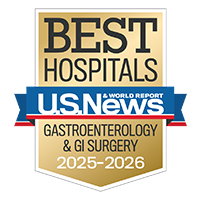Primary Sclerosing Cholangitis

Overview
Primary sclerosing cholangitis (PSC) causes inflammation and scarring of the bile ducts located inside and outside the liver. The ducts carry bile — the liquid that helps break down fat in food — out of the liver. As scarring accumulates, the ducts become blocked causing bile to build up in the liver, which damages liver cells. Eventually, if left untreated, PSC can cause liver failure or hardening of the liver, called cirrhosis.
PSC typically begins between the ages of 30 and 50, occurring most often in men. Although the cause of the condition is unknown, research has shown that it may be an autoimmune disorder, meaning that the immune system mistakes certain body parts and organs as foreign invaders and thus wrongly attacks them. PSC also may be genetically linked to another condition, called ulcerative colitis, which causes inflammation of the colon. It is estimated that 70 percent of PSC patients also suffer from ulcerative colitis. In addition, people with PSC have an increased risk of developing cholangiocarcinoma and cancer of the bile ducts.
Our Approach to Primary Sclerosing Cholangitis
UCSF's dedicated team of hepatologists delivers cutting-edge, compassionate care for all kinds of liver disorders, including primary sclerosing cholangitis. As part of a robust research program, we are at the forefront of an exciting new era of better treatment options for liver disease.
For patients who need a transplant, UCSF offers a liver transplant program known for outstanding outcomes and survival statistics that are among the best in the country. Our program helped pioneer techniques that have made transplantation safer and more successful. Transplant provides a cure for some patients with primary sclerosing cholangitis.
Awards & recognition
-

Among the top hospitals in the nation
-

Best in Northern California for gastroenterology & GI surgery
Signs & symptoms
In the early stages of primary sclerosing cholangitis (PSC), you may not experience any symptoms at all. As the disease progresses, symptoms may come and go and are caused by the bile not being drained properly. This can affect liver function and cause the bile to seep into your bloodstream. Symptoms may include:
- Chronic fatigue
- Jaundice, yellowing of the skin and eyes
- Loss of appetite
- Weight loss
- Chronic fatigue
- Chills
- Fever
- Upper abdominal tenderness
Diagnosis
Your doctor will first ask you about your medical history, which can suggest a likelihood of primary sclerosing cholangitis (PSC), especially if there is a history of inflammatory bowel disease and abnormal blood test results.
PSC is diagnosed through a procedure called cholangiography, which involves injecting dye into the bile ducts and taking an X-ray. Cholangiography can be performed as an endoscopic procedure, called endoscopic retrograde cholangiopancreatography (ERCP), through radiology or surgery, or with magnetic resonance imaging (MRI) scans. Cholangiography is performed under sedation. A lighted, flexible endoscope is inserted through the mouth, stomach and then into the small intestine. A thin tube is place through the scope into the bile ducts and dye is injected to highlight the bile ducts on the X-ray. If there is a narrowing of the bile ducts, the diagnosis of PSC is confirmed.
As the disease progresses, a liver biopsy is usually needed to confirm PSC, and determine how much damage has occurred. Under local anesthesia, a slender needle is inserted through the right lower chest to extract a small piece of liver for microscopic analysis.
Treatments
Treatment for primary sclerosing cholangitis (PSC) includes medication to reduce itching and jaundice, antibiotics to treat infections and vitamin supplements since people with PSC are often deficient in vitamins A, D and K. In some cases, surgery to open major blockages in the common bile duct also is necessary. In addition, liver transplantation may be required and in some cases, can cure PSC.
UCSF Health medical specialists have reviewed this information. It is for educational purposes only and is not intended to replace the advice of your doctor or other health care provider. We encourage you to discuss any questions or concerns you may have with your provider.

















